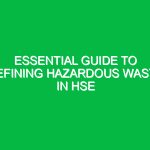Introduction
In the realm of Health, Safety, and Environment (HSE), the terms “danger signs” and “warning signs” play a pivotal role in risk management and Safety protocols. These signs serve as visual cues to indicate potential Hazards, guiding both professionals and the general public to take necessary Precautions. Understanding and properly interpreting these signs is essential for HSE professionals, as they form the first line of defense against accidents and unsafe practices.
Danger signs signal immediate risks that could lead to severe harm or injury, while warning signs advise caution regarding less critical but still significant Hazards. This article will explore the critical dangers and warning signs that every HSE professional must know, providing insights into their importance, regulations governing them, and Best Practices for effective implementation.
The Importance of Danger and Warning Signs in HSE
Understanding danger and warning signs is not merely an academic exercise; it has real-world implications. These signs are integral to Occupational Health and Safety, ensuring that employees and the public are alerted to potential risks. For instance, a construction site may display danger signs indicating the presence of heavy machinery or hazardous materials, while a laboratory might use warning signs to indicate the presence of toxic chemicals.
Without these visual indicators, individuals may unwittingly expose themselves to serious hazards. HSE professionals must ensure that such signs are correctly placed and maintained, as their visibility and clarity can significantly impact safety outcomes.
Key Components of Danger and Warning Signs
Types of Danger Signs
Danger signs are primarily categorized based on the level of risk they represent. Here are some common types:
- High Voltage Signs: Indicating areas where Electrical Hazards are present.
- Chemical Hazard Signs: Warning against exposure to toxic substances.
- Flammable Material Signs: Indicating the presence of combustible materials.
- Biological Hazard Signs: Alerting to the presence of infectious agents.
Each of these signs serves a unique purpose and is designed to communicate specific risks effectively. For example, a high voltage sign typically features a lightning bolt symbol, universally recognized as a danger indicator.
Types of Warning Signs
Warning signs, on the other hand, generally denote less immediate hazards but still require attention. They include:
- Slippery Surface Signs: Indicating areas where the floor may be wet or slick.
- Construction Zone Signs: Alerting individuals to hazards related to ongoing construction activities.
- Noise Hazard Signs: Indicating areas where noise levels may exceed safe limits.
- Restricted Area Signs: Denoting zones that are off-limits to unauthorized personnel.
These signs are crucial in preventing accidents and ensuring that individuals remain aware of their surroundings.
Real-Life Examples of Danger and Warning Signs
To illustrate the importance of danger and warning signs, consider the case of a manufacturing plant that had a serious incident due to inadequate signage. An employee, unaware of the flammable materials stored in a particular area, inadvertently exposed them to an open flame. This incident not only resulted in injury but also led to significant financial losses for the company.
In another instance, a construction site was able to avoid a major accident due to the presence of clear warning signs indicating a restricted area. Workers adhered to the guidelines, preventing unauthorized personnel from inadvertently entering a zone where heavy machinery was in Operation.
These examples underscore the necessity of effective signage and the role HSE professionals play in ensuring that danger and warning signs are not only present but also meaningful and well-understood.
Best Practices for Implementing Danger and Warning Signs
Implementing danger and warning signs effectively requires adherence to several Best Practices:
1. Regular Audits and Inspections
Conduct regular audits of your workplace to evaluate the visibility and condition of all danger and warning signs. Ensure that they are not obstructed by equipment or debris and that they remain legible and intact.
2. Training and Awareness
Provide comprehensive Training for all employees on the meanings of various signs and the corresponding actions they should take. Awareness programs can reinforce the importance of these signs in maintaining a safe work environment.
3. Consistency in Signage
Ensure that the design and color schemes of signs are consistent throughout your facility. This consistency helps reinforce recognition and understanding among employees.
4. Utilizing Technology
Incorporate digital signage where appropriate. Digital warnings can be updated in real-time, providing up-to-date information about emerging hazards.
5. Engaging Employees
Encourage employees to participate in the process by reporting any signs that are damaged or unclear. Employee involvement fosters a culture of safety and accountability.
Regulations and Standards Governing Danger and Warning Signs
Several Regulations and standards govern the use of danger and warning signs in various industries. Understanding these legal requirements is crucial for HSE professionals to ensure compliance and enhance Workplace Safety.
Occupational Safety and Health Administration (OSHA) Standards
In the United States, osha sets forth regulations regarding Hazard Communication and the use of signage. According to OSHA standards, employers must inform employees about hazardous materials in the workplace and provide appropriate signage to warn of potential dangers.
International Organization for Standardization (ISO)
ISO standards, particularly ISO 7010, specify graphical symbols for safety signs. These symbols are universally recognized, which enhances communication across language barriers and promotes understanding of safety hazards globally.
Local Regulations
In addition to federal regulations, various states and municipalities may have specific requirements regarding signage. HSE professionals must stay informed about local laws to ensure compliance and promote safety effectively.
Conclusion
In conclusion, recognizing and understanding danger and warning signs is essential for every HSE professional. These signs not only facilitate immediate awareness of hazards but also contribute to a broader safety culture within organizations. By implementing best practices, adhering to regulations, and fostering a culture of safety, HSE professionals can significantly reduce risks and enhance overall Workplace Safety.
As the landscape of Workplace Safety continues to evolve, it is imperative for professionals in the field to stay informed about the latest standards and practices. By doing so, they contribute to a safer environment for all employees, ultimately promoting health, safety, and environmental Sustainability.
By prioritizing danger and warning signs, HSE professionals can ensure that every individual is equipped with the knowledge necessary to recognize and respond to potential hazards, thereby fostering a culture of safety and proactive risk management.


